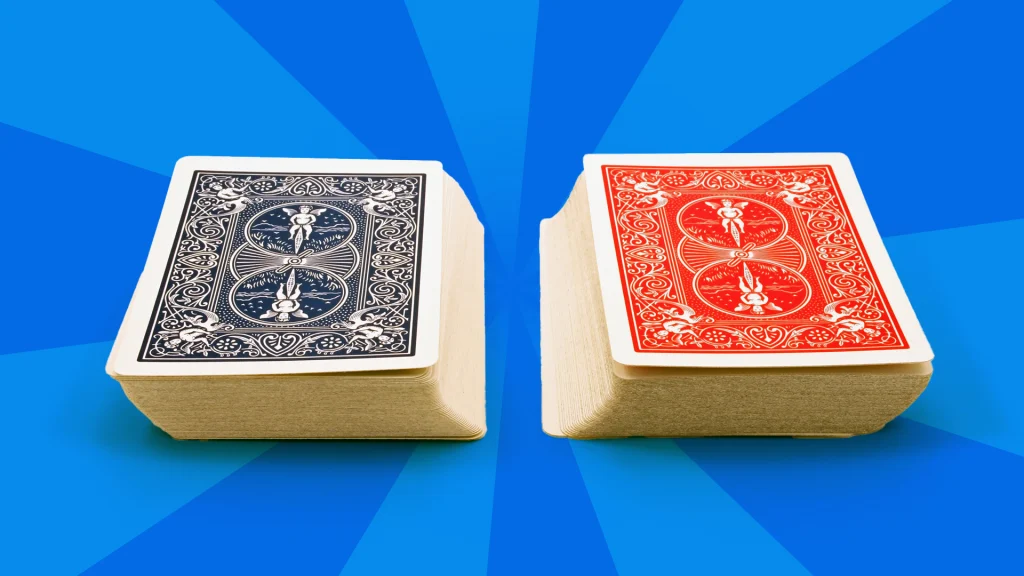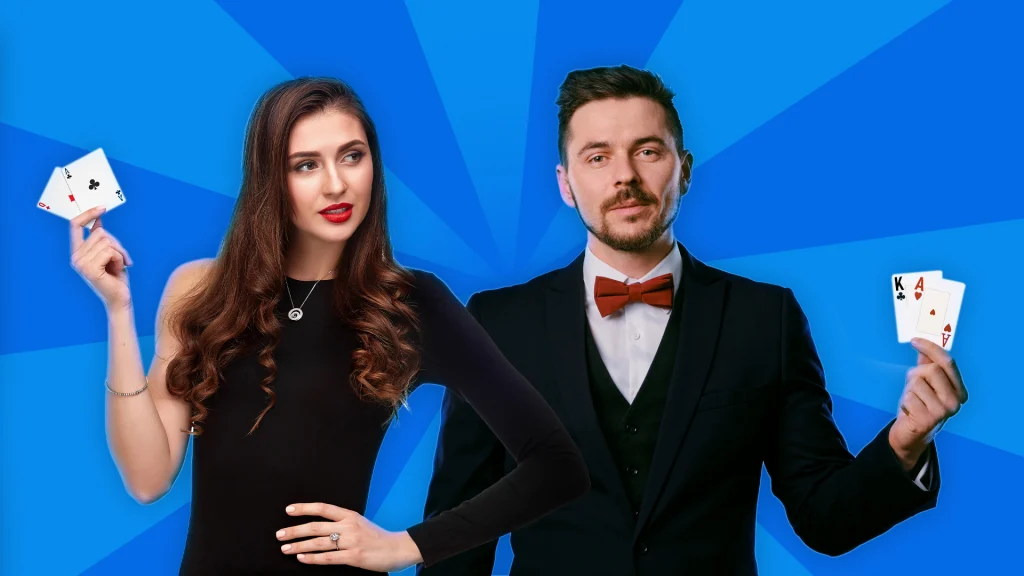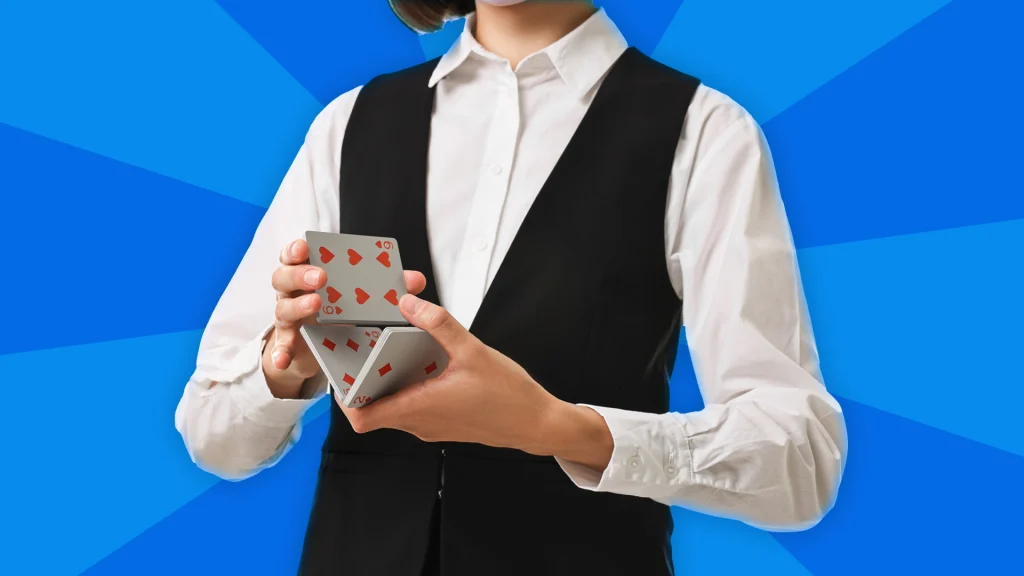How many decks are used in Blackjack?
On the outside, it might feel like the number of decks in blackjack is just a random choice, but in reality, there’s a good reason. The number of decks directly impacts the odds and strategy – but not just for you – for the casino, too.
Single-deck blackjack has been around since the early days of Vegas when players enjoyed some of the best odds with fewer cards to count. However, once players started getting too good at working the single deck, casinos found ways to level the playing field. Over time, they introduced double-deck blackjack and then full-on multiple-deck games to maintain a strong house edge.
So, how many decks are used in blackjack today? And which number gives you the best chance to win? Let’s break it down, one deck at a time.
| Number of decks | House advantage |
|---|---|
| Single deck | 0.17% |
| Double deck | 0.46% |
| Four decks | 0.60% |
| Six decks | 0.64% |
| Eight decks | 0.66% |
Disclaimer: House edge calculated under the following rules: double after split allowed, resplit to four hands allowed, no hitting split aces, no surrendering, double on any two cards, original bets only lost on dealer blackjack, dealer hits soft 17, and cut-card used. Rules differ from game to game and the numbers above are not a guarantee of RTP in every game of Blackjack.
Single-deck Blackjack
Single-deck blackjack is where it all started. It’s the OG version of the game, back when Vegas dealers still called you ‘kid.’
With just 52 cards in play, it’s easy to follow, quick to deal, and gives you the most control over your strategy. Back in the day, this was the way to play. Then, slowly but surely, casinos phased it out because it gave players too much of an edge, particularly for card counters.
Today, finding true single-deck blackjack in land-based casinos is about as rare as finding a payphone (and then you’d have to flip through the phone book in your bedazzled denim jacket to find the nearest casino). If you do, it’s probably packed with rule changes to tilt the odds back to the house, like 6:5 payouts on blackjack instead of 3:2 or restrictions on doubling down.
Single-deck blackjack paying 3:2 has an incredible 0.17% house edge and is easier to find online. Still, online casinos use random number generators (RNGs) that reshuffle after every hand, making card counting useless. The odds still reflect a single deck, but you can’t track what’s been played.
Double-deck Blackjack

Double-deck blackjack is the middle ground between single-deck strategy and security for the casinos. With two decks in play (104 cards total), the house edge is still low at around 0.46%, but counting cards gets trickier. You also play with more 10-value cards, which slightly increases your chances of landing strong hands.
Like with single-deck blackjack, to balance things out, casinos often tweak the rules, like limiting doubling down, restricting splits, or paying 6:5 on blackjack instead of 3:2.
Online, double-deck games follow the same pattern as single-deck: if it’s RNG-based, it reshuffles every hand, making it impossible to count cards. But if it’s a live dealer game with real decks, the odds play out more naturally.
Choosing the right number of decks in blackjack is one way to get ahead. Another is to collect a cash referral bonus before you even start. When you refer a friend to Cafe Casino, your bankroll gets a cash boost from the house.
Multiple-deck Blackjack
Once casinos realized players could outmaneuver single and double-deck games, they cranked up the deck count. Now, most land-based blackjack tables use six to eight decks shuffled together in a shoe, making card counting a tough uphill battle.
More decks mean a smaller chance of drawing blackjack because of a lower concentration of 10-value cards. It also raises the house edge to 0.60% and over.
Blackjack frequency isn’t the only thing that changes, as other hands become more common, too. With more decks in play, you’ll see more soft hands (like A-5 or A-6) and fewer opportunities to double down aggressively since strong hands like 9-10-11 are slightly less frequent.
Online, most blackjack variations follow suit with multiple decks, so if you’re just here for the fun, crack open a drink and enjoy a multi-deck game since they’re the most widely available. But if you’re playing for the best odds, strap on your coonskin cap and spend a few minutes hunting for a good single-deck game.
Another way to stack the deck in your favor is to choose the most beneficial deposit method. Cafe Casino is a crypto casino, which means when you deposit with Bitcoin or other crypto, you’ll get bigger, more frequent bonuses and smoother transactions without any hassles from your bank.
How many decks give the best odds for Blackjack?

So, how many decks are used in blackjack if you want the best odds? One, if you can find a good game.
Single-deck blackjack has the lowest house edge of around 0.17% with perfect strategy, like an optimal strategy chart.
The next best option is double-deck. When comparing single-deck vs. double-deck blackjack, two decks slightly increase the house edge to around 0.46%, but it’s still way better than six or eight decks, which can push the edge over 0.60%. Although, TBH, 0.60% is still incredible for any table game, so it still places blackjack at the head of the table game pack.
Why are casinos increasing the number of decks?
Casinos love blackjack, but they love it a little less when you’re the one always winning. You can relate if you’ve ever played Mario Kart with your older sibling.
So, how many decks do casinos use in blackjack these days? Way more than before. Back then, single-deck games were the standard, but they gave sharp players too much power. It was too easy to track cards and pull off card counting. Naturally, casinos weren’t about to let that slide, so they piled on more decks to balance it out.
With more decks, it’s harder to predict the next card. There are more 10-value cards, but the low-value cards dilute them, so blackjack happens less often, and the house edge creeps up.
Another advantage for casinos to adding more decks is the timing of the rounds. With just one deck, the dealer needs to shuffle the cards after every round to start fresh. With multiple decks, they can shuffle less often, like once every several hands, instead.
How many possible deck shuffles are there?

Oh, goody, it’s time to get nerdy.
The number of ways you can shuffle a standard 52-card deck is a mind-blowing 8 × 10⁶⁷. That’s an 8 followed by 67 zeros. To put that in perspective, if you shuffled a deck every second since the dawn of time, you wouldn’t even be close to repeating the same order…and at that point, you’d deserve a comped room just for the commitment.
Now, imagine adding more decks. Casinos usually have six to eight decks, which means the number of possible shuffles is so large it’s practically infinite. No two games of blackjack will ever see the same sequence of cards, no matter how many hands you play.
Next time you see the dealer shuffle, just know that you’re witnessing a random mix that no human, computer, or time traveler could ever predict perfectly. If you ask us, that makes blackjack even more magical.
When you play blackjack, the number of decks changes everything, from your odds to your strategy. Fewer decks mean better chances, so look for single-deck blackjack with player-friendly rules to enjoy the best odds. For all types of blackjack, play for free in Practice Play at Cafe Casino, then make the switch to Real Play once the skills are stacked in your hand.